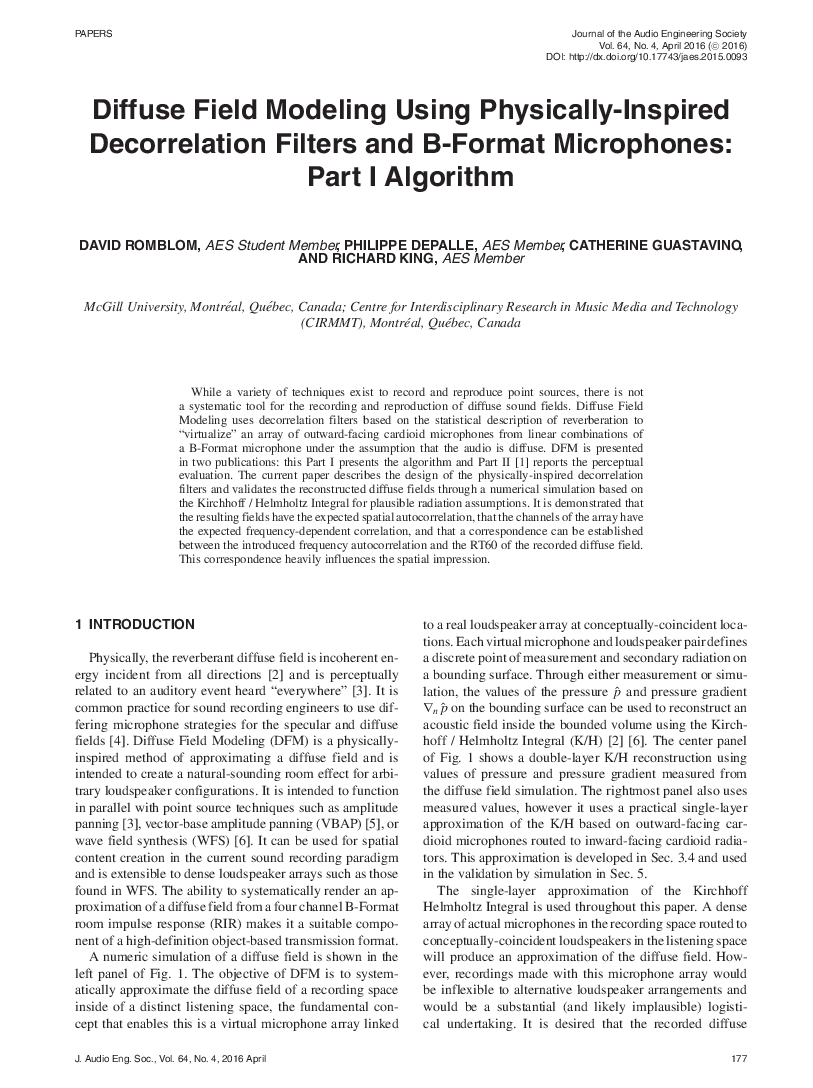Home / Publications / E-library page
You are currently logged in as an
Institutional Subscriber.
If you would like to logout,
please click on the button below.
Home / Publications / E-library page
Only AES members and Institutional Journal Subscribers can download
A reverberant diffuse sound field is characterized by incoherent energy arriving from all directions and is perceptually described as an auditory event that is heard everywhere. It is common practice for sound recording engineers to use differing microphone strategies for the direct and diffuse fields. While there are a variety of techniques to record and reproduce point sources, a systematic tool for diffuse sound fields does not exist. Diffuse Field Modeling (DFM) is a physically-inspired method for approximating a diffuse field in order to create a natural-sounding room effect for arbitrary loudspeaker configurations. It is intended to function in parallel with point source techniques. Using a statistical description of reverberation, the decorrelation filters in DFM are based on physical acoustics, and the resulting diffuse fields are validated with simulations incorporating the Kirchhoff/Helmholtz Integral. The resulting diffuse fields have the expected spatial autocorrelation, and the channels of the array have the expected frequency-dependent correlation. The filters can be tuned to introduce random variation that has physically-plausible frequency autocorrelation, which strongly influences the spatial impression.
Author (s): Romblom, David; Depalle, Philippe; Guastavino, Catherine; King, Richard
Affiliation:
McGill University, Montréal, Québec, Canada; Centre for Interdisciplinary Research in Music Media and Technology (CIRMMT), Montréal, Québec, Canada
(See document for exact affiliation information.)
Publication Date:
2016-04-06
Import into BibTeX
Permalink: https://aes2.org/publications/elibrary-page/?id=18127
(897KB)
Click to purchase paper as a non-member or login as an AES member. If your company or school subscribes to the E-Library then switch to the institutional version. If you are not an AES member Join the AES. If you need to check your member status, login to the Member Portal.

Romblom, David; Depalle, Philippe; Guastavino, Catherine; King, Richard; 2016; Diffuse Field Modeling Using Physically-Inspired Decorrelation Filters and B-Format Microphones: Part I Algorithm [PDF]; McGill University, Montréal, Québec, Canada; Centre for Interdisciplinary Research in Music Media and Technology (CIRMMT), Montréal, Québec, Canada; Paper ; Available from: https://aes2.org/publications/elibrary-page/?id=18127
Romblom, David; Depalle, Philippe; Guastavino, Catherine; King, Richard; Diffuse Field Modeling Using Physically-Inspired Decorrelation Filters and B-Format Microphones: Part I Algorithm [PDF]; McGill University, Montréal, Québec, Canada; Centre for Interdisciplinary Research in Music Media and Technology (CIRMMT), Montréal, Québec, Canada; Paper ; 2016 Available: https://aes2.org/publications/elibrary-page/?id=18127
@article{romblom2016diffuse,
author={romblom david and depalle philippe and guastavino catherine and king richard},
journal={journal of the audio engineering society},
title={diffuse field modeling using physically-inspired decorrelation filters and b-format microphones: part i algorithm},
year={2016},
volume={64},
issue={4},
pages={177-193},
month={april},}
TY – paper
TI – Diffuse Field Modeling Using Physically-Inspired Decorrelation Filters and B-Format Microphones: Part I Algorithm
SP – 177 EP – 193
AU – Romblom, David
AU – Depalle, Philippe
AU – Guastavino, Catherine
AU – King, Richard
PY – 2016
JO – Journal of the Audio Engineering Society
VO – 64
IS – 4
Y1 – April 2016